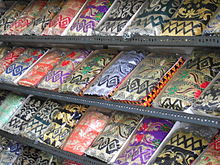ടപിസ് (ഇന്തോനേഷ്യൻ നെയ്ത് രീതി)

ഇന്തോനേഷ്യയിലെ ലംപങ് പ്രവിശ്യയിലെ ഒരു നെയ്ത്ത് കലയാണ് ടപിസ് (Indonesian: kain tapis) . ഈ രീതിയനുസരിച്ച് നെയ്ത തുണിക്കും ടപിസ് എന്ന് പറയാറുണ്ട്. സ്വാഭാവിക നിറം കൊടുത്ത് തുന്നൽ വേലകൾ ചേർത്ത വരകളൂള്ള നെയ്ത്ത് രീതിയാണീത്. അതിനു ഒരുപാട് തരാതരങ്ങളൂണ്ട്. ഇതൊരുതരം ആഡംബരവേലയാണെങ്കിലും അലങ്കാരത്തിനും അത് ഉപയോഗിക്കാം. ഇതിനെ ലംപങ് പ്രദേശത്തിന്റെ തനത് കലയായി കണക്കാക്കുന്നു.
നിർമ്മാണം[തിരുത്തുക]

ലംപങ് നാരികളുടെ കലയാണ് ടപിസ്. അത് സ്വാഭാവിക നിറം ചേർത്ത നാട്ടിൽ നെയ്ത തുണിത്തരമാണ്. അതിൽ കസവുനൂലും വെള്ളിനൂലും ചേത്ത്യും തുന്നല്പണികളും ചെയ്യുന്നു. .[1][2] സ്വർണ്ണ നാരുകൾ വരകളായും കോണങ്ങളായും ചതുരങ്ങളായും തുന്നിച്ചേർക്കുന്നു. .[1][2] Tapis can also be decorated with beads, mica chips, or old colonial coins.[1][3][4]

സ്വർണ്ണ എംബ്രോയഡറി സാധാരണ കൗച്ചിങ് വഴിയാണ് തുന്നിച്ചേർക്കുന്നത്. അതുവഴി അവശേഷം കുറയുന്നു. [5] The gold thread is attached in sections, then couched with a different, less expensive, thread at turns. This ensures that none of the gold thread is used in a non-visible area.[5][6]
പാരമ്പര്യമായി ടപിസ് പൂക്കൽ വേലയുണ്ട്. ഇപ്പോൾ പുതിയ രീതിയനുസരിച്ച് നെയ്ത്തുകാരന്റെ ഭാവനക്കനുസരിച്ചും ചെയ്യാറുണ്ട്. അറബിക് സെല്ലിഗ്രാഫി അത്തരം പുതിയ ഒരു കൈവേലയാണ്. .[4] Other designs may include snakes, ships, and mythical creatures.[2] ടപിസ് ടുവ tapis tua (old tapis), areപൂർണ്ണമായും സ്വർണ്ണവേലയാണ്.[7]
Although generally produced by Lampungese home industries, tapis is also produced in other areas, including Kendal, Central Java[1] and Pisang Island.[8]
Use[തിരുത്തുക]
Traditionally, tapis is worn as a sarong for weddings, Eid ul-Fitr celebrations, and welcoming ceremonies. However, tapis can also be used as a wall decoration.[4] When worn, it forms a cylinder around the wearer's legs.[9]
Reception[തിരുത്തുക]

Tapis has come to be seen as a symbol of Lampung.[1]
Stevie Emilia of the Jakarta Post describes tapis as having "exceptional beauty and sophistication",[10] while Jill Forshee describes viewing tapis as "like seeing countless possibilities in art and life portrayed in cloth".[6]
The price of tapis reflects its age. Generally, the older a tapis the more it costs. Antique tapis are also collectors items, collected by both Indonesians and foreigners.[1]
References[തിരുത്തുക]
- Footnotes
- ↑ 1.0 1.1 1.2 1.3 1.4 1.5 Oyos Saroso (22 January 2007). "Rusiana Makki, empowering women through 'tapis'". The Jakarta Post. Archived from the original on 2012-03-24. Retrieved 6 August 2011.
- ↑ 2.0 2.1 2.2 Maxwell 2003, പുറങ്ങൾ. 112–113
- ↑ Rodgers, Summerfield & Summerfield 2007, പുറം. 36
- ↑ 4.0 4.1 4.2 Nia S. Kim (10 June 2001). "Lampung offers a whole lot more besides jungle adventures". The Jakarta Post. Archived from the original on 2012-10-12. Retrieved 6 August 2011.
- ↑ 5.0 5.1 Maxwell 2003, പുറം. 316
- ↑ 6.0 6.1 Forshee 2006, പുറം. 144
- ↑ (Maxwell 2003, പുറം. 184)
- ↑ Backshall 2003, പുറം. 502
- ↑ Maxwell 2003, പുറം. 319
- ↑ Stevie Emilia (10 April 2011). "Journeying through textile traditions". The Jakarta Post. Retrieved 6 August 2011.
- Bibliography
- Backshall, Stephen (2003). The Rough Guide to Indonesia. Rough Guides. p. 565. ISBN 1-85828-991-2. Retrieved 20 December 2010.
{{cite book}}: Invalid|ref=harv(help) - Forshee, Jill (2006). Culture and Customs of Indonesia. Westport, Connecticut: Greenwood Press. ISBN 978-0-313-33339-2. Retrieved 6 August 2011.
{{cite book}}: Invalid|ref=harv(help) - Maxwell, Robyn J. (2003). Textiles of Southeast Asia : Tradition, Trade, and Transformation. Hong Kong: Periplus. ISBN 978-0-7946-0104-1. Retrieved 6 August 2011.
{{cite book}}: Invalid|ref=harv(help) - Rodgers, Susan; Summerfield, Anne; Summerfield, John (2007). Gold Cloths of Sumatra : Indonesia's Songkets from Ceremony to Commodity. Leiden: KITLV Press. ISBN 978-90-6718-312-3. Retrieved 6 August 2011.
{{cite book}}: Invalid|ref=harv(help)[പ്രവർത്തിക്കാത്ത കണ്ണി]
